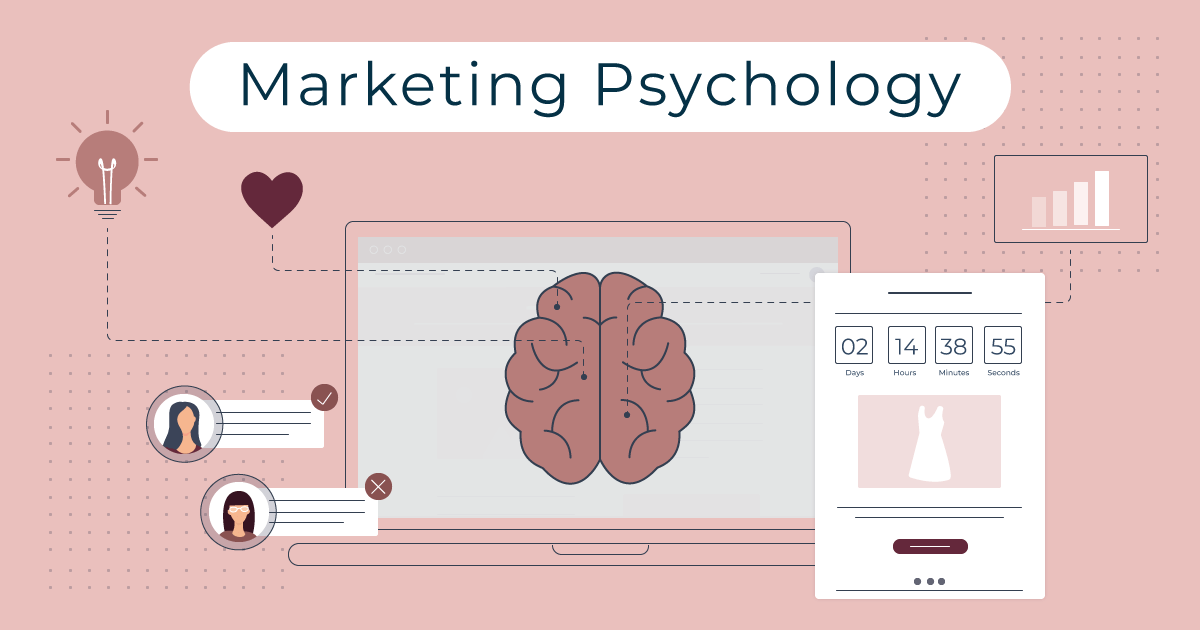
Email Marketing For Hospitals: The Ultimate Guide [2025]
Email marketing may not be the most popular subject among healthcare providers, but it is an important marketing strategy that can hugely benefit healthcare organizations.
A great healthcare email marketing strategy can attract more clients to your facility and keep them satisfied with your excellent services. In addition, it’ll help you stand out from the competition and boost your return on investment.
Therefore, investing in email marketing makes perfect sense for your hospital or private practice. But where exactly should you start? Read this article to learn more about the importance of this digital channel for hospitals and how to use email marketing effectively for optimal ROI.
Why Is Email Marketing Important For Hospitals?
A well-executed email marketing program enables a hospital to nurture long-lasting relationships with its clients. You can achieve this through the following:
- Send timely and personalized email messages
- Educate clients through helpful email content
- Differentiate your organization from competitors
For instance, you can establish your hospital’s credibility through email marketing by delivering impactful content to them. Check this out:
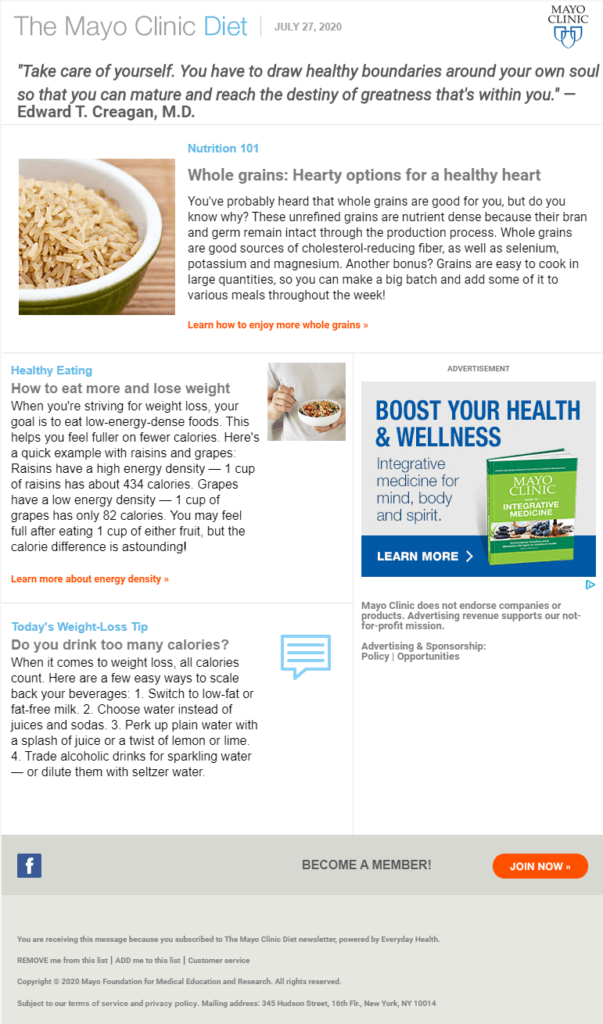
The Mayo Clinic Diet Newsletter offers healthy diet information and tips. This has been instrumental in helping them establish a strong brand reputation and credibility in the healthcare industry. Therefore, to build trust and long-term relationships with your clients, it’s wise to prioritize valuable and top-of-mind email content over promotional.
3 Key Elements Of A Successful Email Marketing Strategy For Hospitals
A thriving healthcare email campaign strategy can be a game changer for hospitals. There are three key elements you need to leverage to succeed:
1. Automation
Email automation lets businesses send the right emails to the right people at the right time. It involves creating automated workflows to deploy certain emails based on set triggers. For example, you can set a trigger to ensure a client receives an email immediately after an appointment. You can also set another trigger for appointment reminders to ensure they arrive on time.
Email automation takes the stress out of email marketing and enables you to save time and resources. Moreover, customers appreciate prompt responses. Once you have appropriately set up your workflows and triggers, the customer experience is elevated.
Furthermore, email automation increases open rates and conversions by facilitating advanced personalization. Every hospital client gets relevant emails that respond to an action they have taken or information that is useful to them at a given time.
To automate your email marketing efforts, you need a top-notch email service like Moosend or Mailchimp. Pick a platform with premade automation recipes and email templates to deliver beautiful, converting campaigns with minimal effort.
2. Segmentation
Briefly, email segmentation is the process of grouping your email subscribers into different segments based on certain shared characteristics. Thus, you send relevant content to a target audience at their moment of need. Doing so lets you avoid spamming your subscribers with irrelevant emails, a typical email marketing mistake that can hurt your sender score and deliverability.
As a hospital, you can group your audience in various ways. Firstly, you can segment them based on the condition they are receiving treatment for. For instance, you could have a segment dedicated to diabetic patients and another for dieting physiotherapy patients.
Here are some additional ways to segment a hospital’s email list:
- According to the location: This segmentation allows you to target your audience based on their location. For instance, if your hospital covers different regions, they might have different flu seasons. Hence, it’s best to send flu management tips to the subscribers in the region about to experience a flu season.
- According to the level of engagement: Customers exist on a spectrum. Some are actively engaged, while some are passively involved. Those actively engaged need regular email communication, while those who are passively engaged need a reminder of your presence occasionally.
- According to website activity: You can tell much about a customer’s behavior by looking at their online activity. For instance, some customers may visit your site and look at pages or posts about a particular topic. You can track such activities using email autoresponders and ensure these customers get health-related information.
These are only some of the ways to segment, though. Study your business and develop customer segments that suit your healthcare practice.
3. Personalization
Email personalization is the process of including specific information readers are highly likely to be interested in. Without it, emails can become too generic, leading to less engagement and more unsubscribes.
Personalization can also increase transaction rates by up to six times. You can start by personalizing email subject lines. This may involve mentioning something the recipient knows, e.g., an appointment they made, a prescription they bought, their name, etc.
For starters, you can use an email subject line tester to come up with various ideas. Then let your email autoresponder enter dynamic content to personalize each subject line.
Here are five more ways to personalize an email:
- Copy: You can include personal details, such as their name and preferences to address them directly.
- Imagery: You can also add personalized imagery, like graphs related to a discussion or an appointment they had with a caregiver.
- Offers: Personalize offers by sending incentives tailored to recipients based on their purchase history and website activity.
- Product recommendations: You can also recommend products that either supplement their purchase or alternatives. Personalized product recommendations are more likely to convert than generic ones.
Finally, you should do proper research and find out what forms of personalization would be effective for your hospital. This will also depend on the robustness of your data and the technology you use for your email marketing campaigns.
7 Best Email Marketing Practices For Healthcare Professionals
So far, you’ve learned why email marketing for hospitals is important and the key elements that make a successful email campaign. It’s time to give you some practical newsletter ideas you can implement immediately. Here they are:
1. Collect New Patient Email Addresses
An email list is a compilation of email contact information of people who have opted in or permitted you to share promotional emails and updates in their email inboxes. From a business perspective, an email list includes prospective patients you can nurture through a sales funnel using your healthcare email marketing strategy.
Whether you work for a clinic or a doctor’s office, here’s how to build your email list:
- Start with current patients: Since you already have a rapport with them, asking for their emails is safe. You can request their email on their next visit or contact them through a call or SMS. Inform them about your intentions, such as sharing news, updates, offers, and promotions.
- Utilize social media: Social media channels provide a relatively easy way to build your email list, especially if you already have a well-established audience. For example, you can share a landing page or link to your newsletter in your social media bio. Here’s how Mayo Clinic did it:
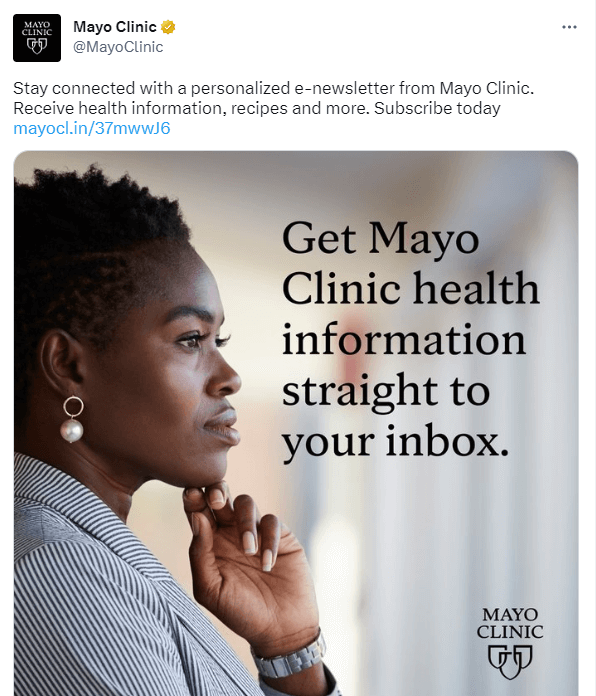
- Create online sign-up forms: You can integrate an email sign-up form to your website based on various triggers. For example, they can appear when a user is about to exit your site – the so-called exit-intent popups.
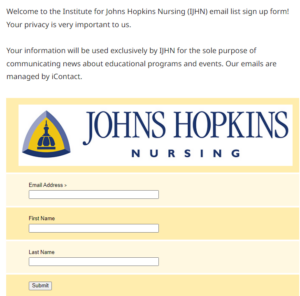
- Run a contest or giveaway: Giveaways in the healthcare industry can include hospital merchandise or free check-ups and consultation in exchange for the patients’ personal information. For example, Columbia Memorial Hospital ran a contest to give out an Automated External Defibrillator to a medical organization.
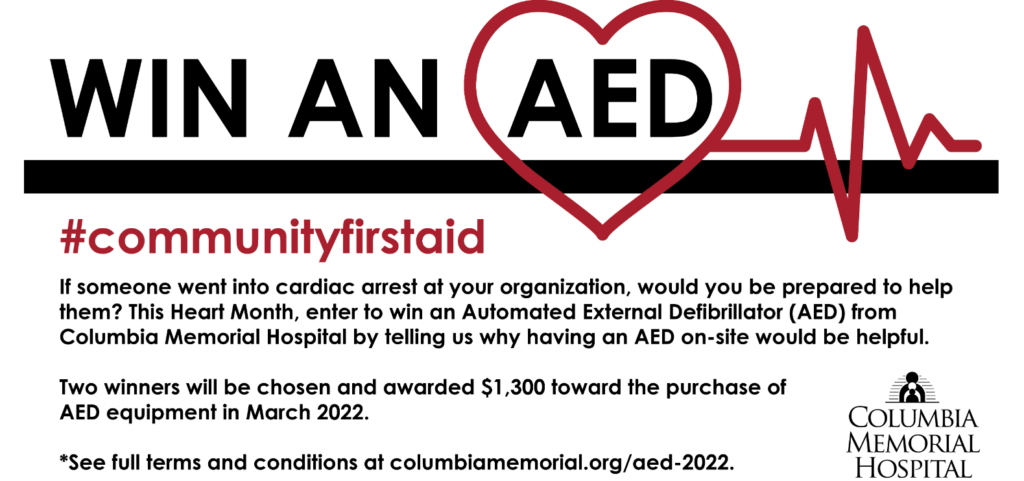
2. Begin With A Welcome Email
Welcome emails are sent to readers when they first subscribe to an email list. It marks the beginning of a relationship between your healthcare facility and the customer. From the tone of the email, a customer can get a feel of how you communicate. Moreover, a welcome email is an opportunity to introduce your services and let the readers know more about your brand.
Mayo Clinic has a superb welcome newsletter:
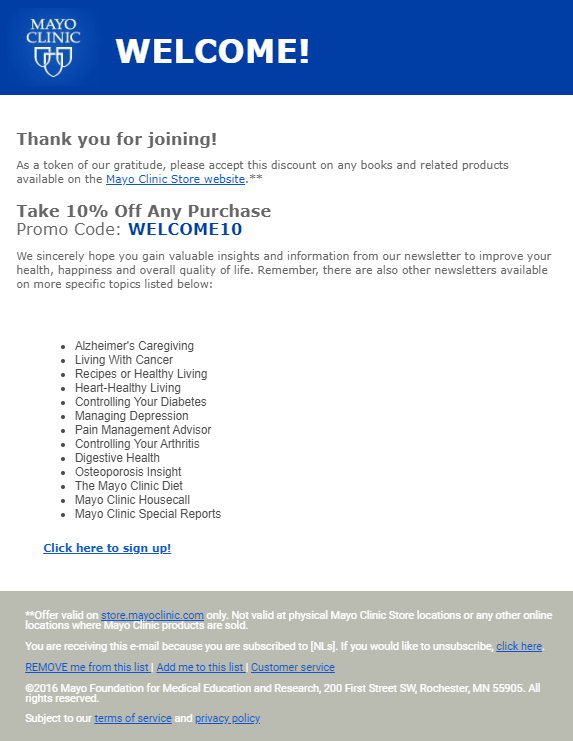
Overall, a great welcome email should have a simple, catchy subject line. It has to be personalized and explain to the reader what the newsletter is all about.
You can also elaborate on the benefits of joining the mailing list. Include a call to action encouraging the reader to explore other aspects of your business. For example, you can add a link leading to your resources center.
3. Send Appointment Confirmation Emails
An appointment confirmation email is triggered when someone books an appointment. Ideally, you should send this email immediately after this action. These email types are called transactional and play a key role in the success of this marketing channel.
This email should be simple. It should acknowledge the appointment and, if needed, provide more information about it, such as the time or location. Here is a good example:
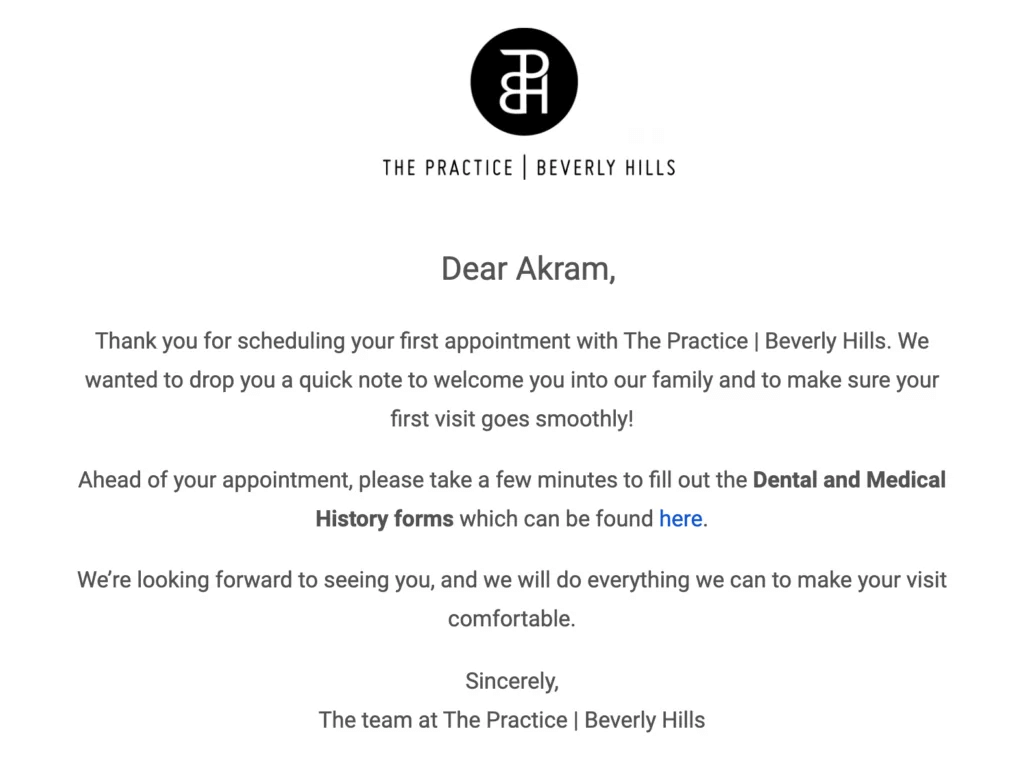
4. Send A Happy Birthday Email
Birthday emails are a great way of showing your clients that you care about them. It shows your goodwill and can be vital for customer engagement and retention. Moreover, they receive high open and click-through rates, and with the appropriate CTAs, can even prompt readers to take further action.
A good birthday email like the one sent by Dr. Anthony Bennet below allows you to connect better with your clients at a deeper level:
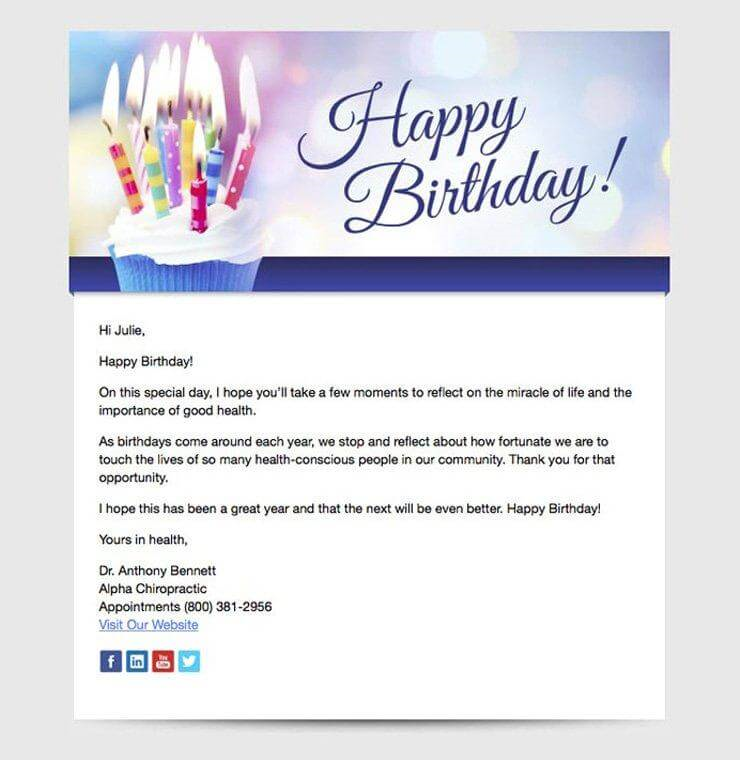
To send them on the right dates, you can either collect them during the newsletter signup process or get them later during the appointment as part of the patient’s history.
5. Send Wellness Tips
Email content should provide value to the reader. Therefore, it’s important to ensure you send helpful healthcare resources to your subscribers that are related to your services. For example, dental clinics could share healthy living tips around dental care. Diabetes clinics can share tips on living with diabetes.
In the example below, Fullscript educates its audience about vitamin C:
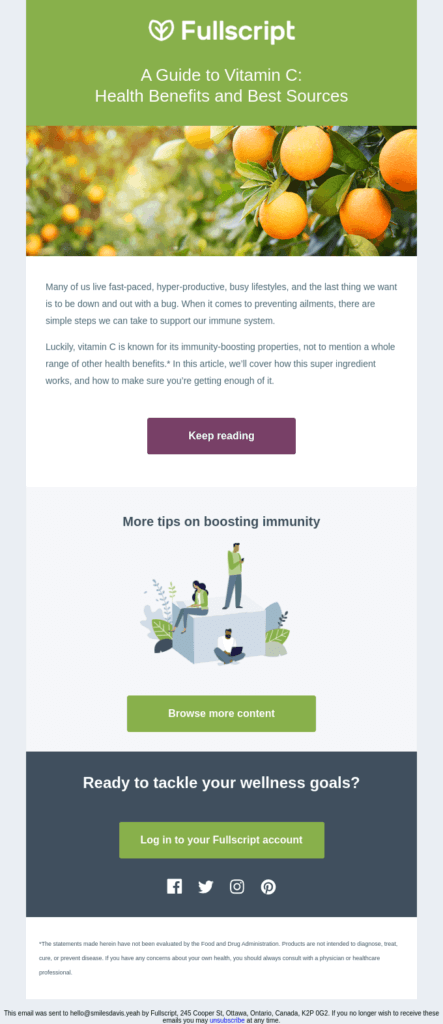
Sharing credible information and healthy living tips establishes you as a reliable source of content, products, and services. It helps readers see you as an authority in your field. This gives you a competitive advantage when they start searching for an expert.
6. Offer Special Promotions
You can also use your newsletters to nurture your audience through special promotions. Here is a great example of a promotional email by Lady Lake Smiles Dentistry:
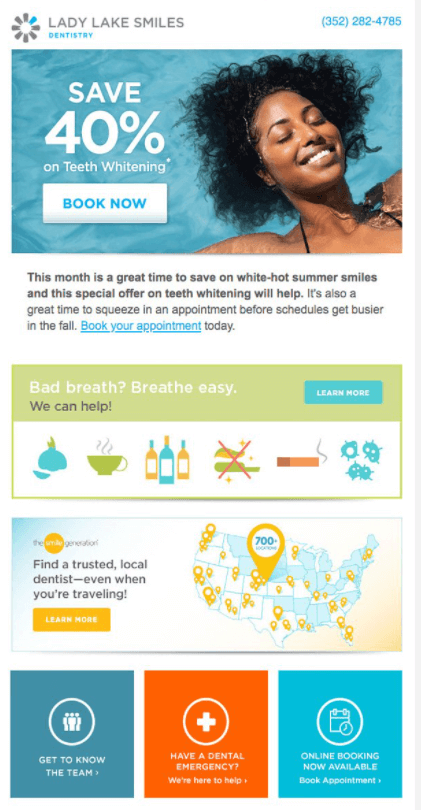
Below are other incentives to provide:
- Limited time offers
- Exclusive deals
- Holiday/seasonal promotions
- Product launches
- New arrivals
- Coupons and discounts
Email segmentation can help you send targeted promotions for optimal results. For instance, if a patient has had their first visit, you can send a discount promotion email after booking their second appointment.
7. Share Client Testimonials
Testimonials are a powerful marketing tool, serving as proof of impressive service delivered. You can source testimonials from your most loyal patients and share them through email.
Below is an example where a couple writes their story of dealing with an ethical dilemma in IVF. Also, at the end of the email, Tennessee Reproductive Medicine (TRM) includes a testimonial of a satisfied client.

Gradually, you can encourage more customers to share their stories. Overall, these reviews boost the credibility of your facility and staff, and improve the confidence of your current and potential clients in your services.
Conclusion
A healthcare email marketing campaign can be a phenomenal marketing tactic for hospitals. To execute it right, you first need to build a robust email list, which is an ongoing process. You can start by collecting the email addresses of your current patients, and use social media and signup forms to attract a new audience.
The email campaign must also be automated, segmented, and personalized for maximum results. Automate emails to reduce your workload and boost the efficiency of your email campaigns. Finally, segmentation and personalization ensure that you target the right customers at the right time with the right product, service offers, recommendations, etc.
Interested in streamlining an email marketing process for your healthcare center? Sign up for a Moosend account and get ready to improve your metrics using our top-notch features.
Author Bio:
Austin Andrukaitis
Entrepreneur Leadership Network Writer
Austin Andrukaitis is the CEO of ChamberofCommerce.com. He’s an experienced digital marketing strategist with many years of experience in creating successful online campaigns. Austin’s approach to developing, optimizing, and delivering web-based technologies has helped businesses achieve higher profit, enhance productivity, and position organizations for accelerated sustained growth.
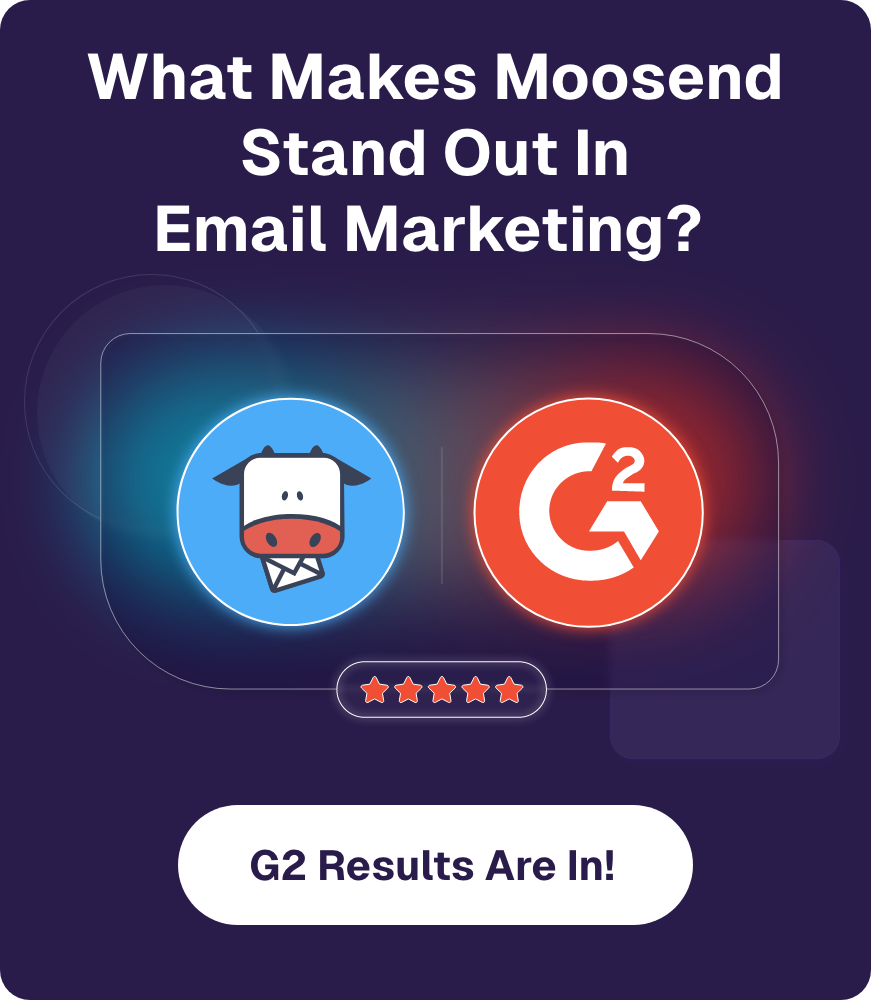
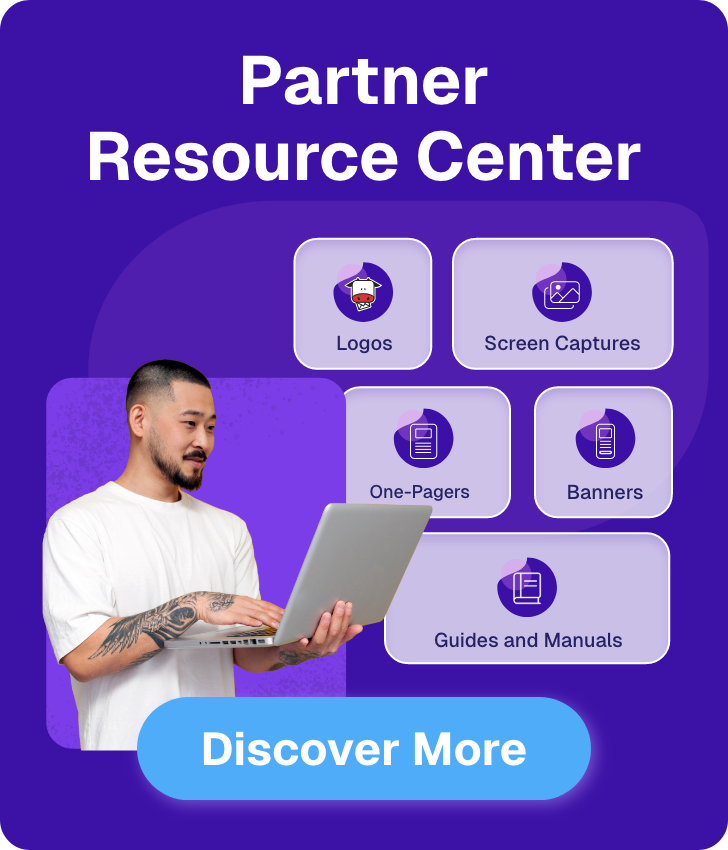

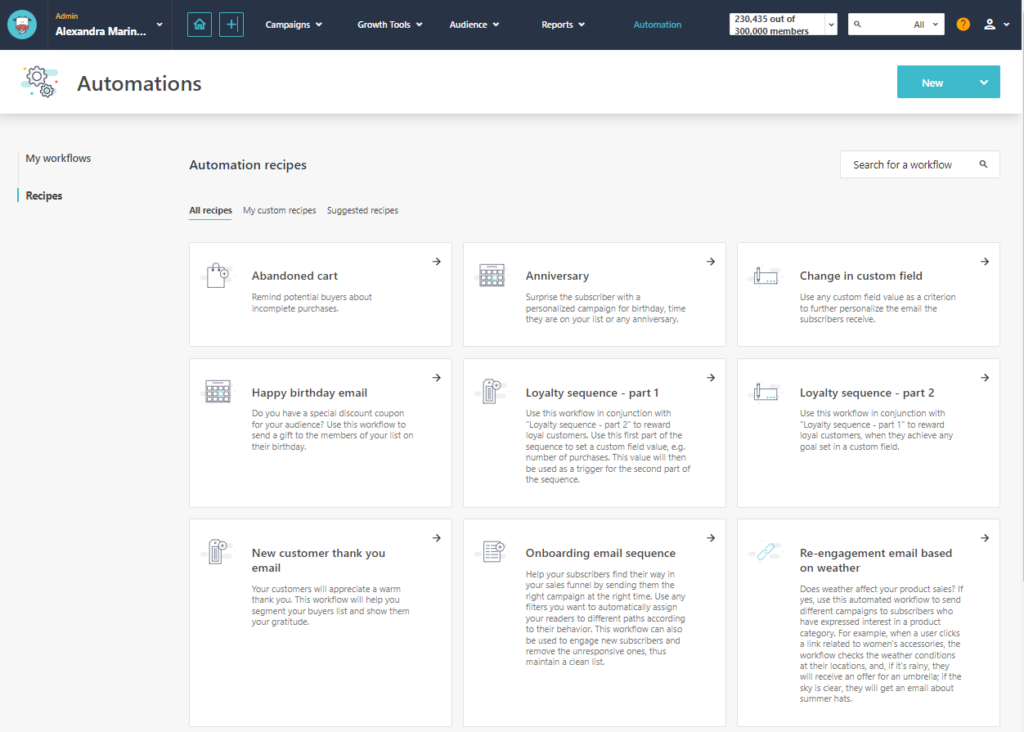
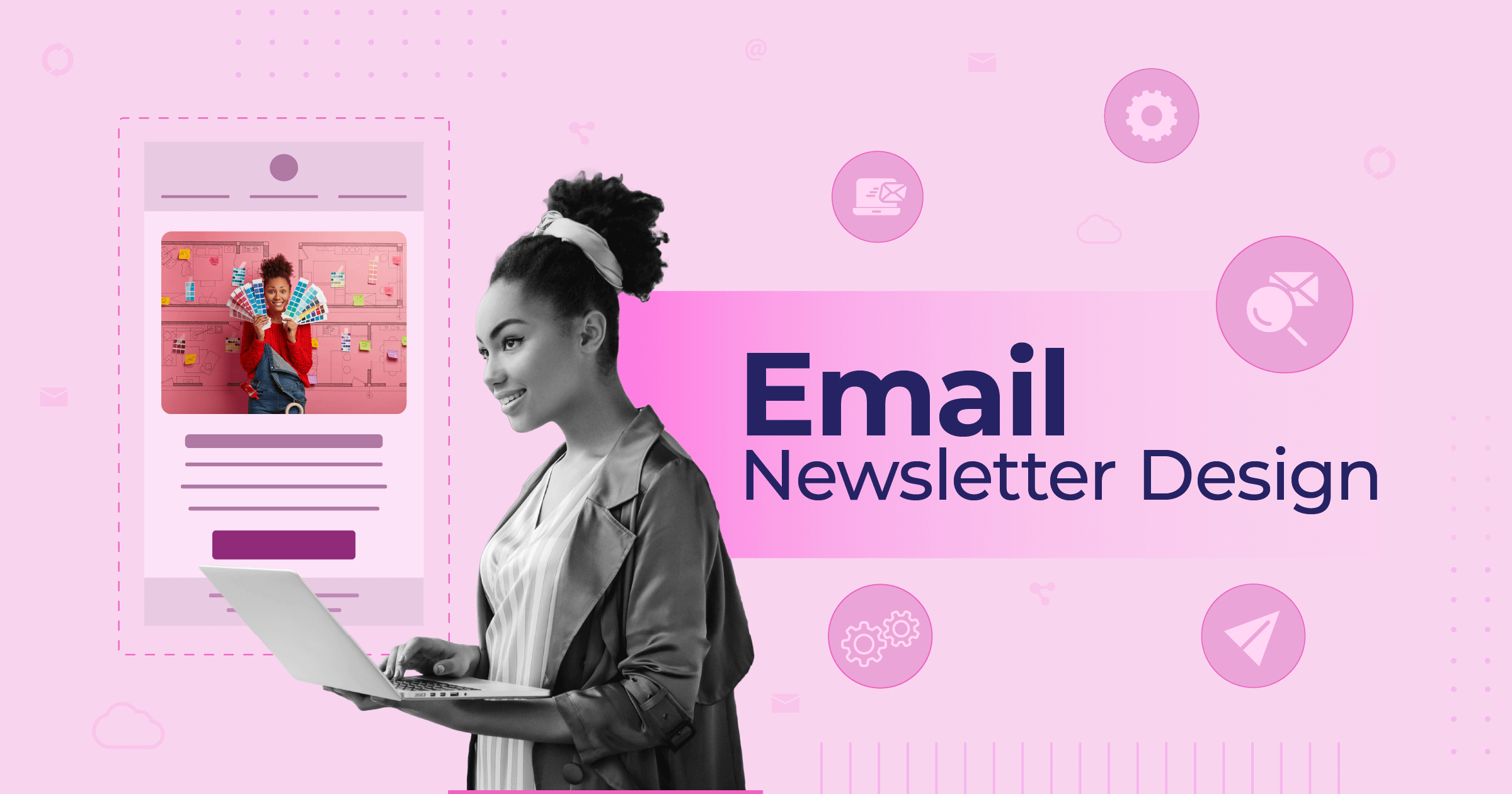
 Published by
Published by
